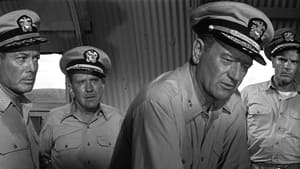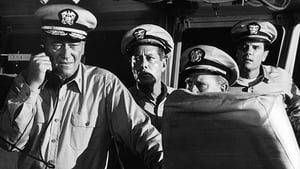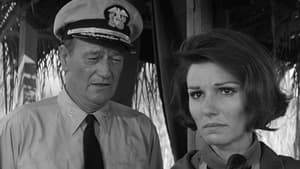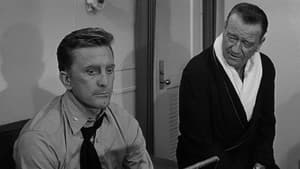Video Sources 0 Views
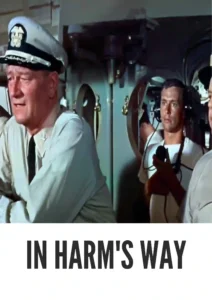
Synopsis

Prepare for an epic journey through love, loss, and courage with In Harm’s Way, a historical romantic war film from 1965, now beautifully colorized to immerse you in its sweeping narrative. Produced and directed by Otto Preminger and featuring a stellar cast, including John Wayne and Kirk Douglas, this film masterfully weaves together the personal lives of naval officers with the large-scale events of World War II. Perfect for fans of classic war movies and those seeking a complex and emotional cinematic experience, this HD download brings a fresh perspective to a timeless story of heroism and sacrifice.
In Harm’s Way unfolds against the backdrop of the attack on Pearl Harbor and the first year of the United States’ involvement in World War II. The film centers on Captain Rockwell “Rock” Torrey (John Wayne), a divorced naval officer who faces professional setbacks and personal challenges as he navigates the tumultuous events of the war.
After being relieved of his command for his actions during the Pearl Harbor attack, Torrey finds himself reassigned to desk duty. Meanwhile, Commander Paul Eddington (Kirk Douglas), Torrey’s executive officer, struggles with the infidelity and tragic death of his wife. As Torrey finds romance with a Navy nurse, Maggie Haynes (Patricia Neal), he also attempts to reconcile with his estranged son, Jeremiah, who is now an ensign in the Naval Reserve.
Torrey’s career takes an unexpected turn when he is promoted to rear admiral and given tactical command of a crucial South Pacific offensive. Reunited with Eddington, Torrey faces both the external threat of the Japanese forces and the internal struggles of his own officers. The film explores themes of honor, courage, and the devastating impact of war on personal relationships, culminating in a dramatic naval battle and profound sacrifices.
The film features an impressive ensemble cast, each delivering compelling performances:
-
John Wayne as Captain (later Rear Admiral) Rockwell W. “Rock” Torrey
-
Kirk Douglas as Commander (later Captain) Paul Eddington
-
Patricia Neal as Lieutenant Maggie Haynes
-
Tom Tryon as Lieutenant William “Mac” McConnell
-
Paula Prentiss as Beverly McConnell
-
Brandon deWilde as Ensign Jeremiah Torrey
-
Jill Haworth as Ensign Annalee Dorne
-
Dana Andrews as Vice Admiral B. T. Broderick
-
Stanley Holloway as Clayton Canfil
-
Burgess Meredith as Commander Egan Powell
-
Franchot Tone as CINCPAC
-
Henry Fonda as CINCPAC
In Harm’s Way is an epic historical romantic war film that combines elements of drama, action, and romance to create a multifaceted cinematic experience. It delves into the personal lives of its characters against the backdrop of World War II, exploring themes of courage, sacrifice, and the human cost of war.
Released in 1965, In Harm’s Way reflects the American perspective on World War II, offering a nuanced portrayal of the U.S. Navy and its officers during a critical period in history. The film captures the spirit of the time, depicting the challenges and sacrifices faced by those who served in the war, as well as the personal struggles they endured. Its exploration of complex themes and its star-studded cast made it a significant cinematic event of the era.
This colorized version of In Harm’s Way has been meticulously restored using state-of-the-art digital techniques, enhancing the visual appeal while preserving the film’s original integrity. The colorization process involved a careful analysis of the grayscale tones in the original black and white footage, with painstaking attention paid to assigning appropriate colors to each scene. While the specific software used remains proprietary, the methods employed included advanced algorithms for color palette selection, motion estimation, and image enhancement. This meticulous process breathes new life into the characters and settings, making the story even more captivating for modern audiences. While debates about the merits of colorizing classic films persist, it undeniably introduces these films to a broader audience, ensuring their legacy endures for generations to come.
-
: Otto Preminger
-
: Wendell Mayes, based on the novel Harm’s Way by James Bassett
-
: Loyal Griggs
-
: Hugh S. Fowler
-
: Sigma Productions
-
: Paramount Pictures
-
: 165 minutes
-
: MP4
-
: HD (1080p)
-
: Compatible with most devices, including smartphones, tablets, computers, and smart TVs.
In Harm’s Way (1965) has been praised for its epic scope, its compelling characters, and its exploration of complex themes. It remains a significant film in the war genre, celebrated for its nuanced portrayal of the human experience during World War II. As a sweeping and emotionally resonant film, In Harm’s Way offers a powerful glimpse into a pivotal moment in history.
-
: What is In Harm’s Way about?
-
A: In Harm’s Way is a war film that follows the lives of U.S. naval officers based in Hawaii during the first year of American involvement in World War II, exploring their personal struggles and professional challenges.
-
-
: Is In Harm’s Way (1965) a well-known film?
-
A: In Harm’s Way is a recognized classic, known for its epic scale, star-studded cast, and its depiction of the events surrounding Pearl Harbor and the subsequent war in the Pacific.
-
-
: Is this version of In Harm’s Way colorized?
-
A: Yes, this version has been professionally colorized to enhance the viewing experience.
-
-
: What makes In Harm’s Way interesting for classic film fans?
-
A: In Harm’s Way offers a complex and nuanced portrayal of World War II, with compelling characters and exploration of the human cost of war.
-
-
: What is the download format?
-
A: The download format is MP4, which is compatible with most devices.
-
-
: What resolution is the download?
-
A: The resolution is HD (1080p), providing a high-quality viewing experience.
-
Watch In Harm’s Way Today!
